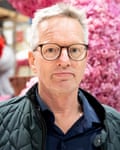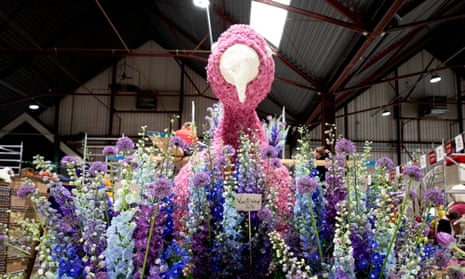Flower farmer John Huiberts stands next to a flamingo made of thousands of organic pink hyacinths. At the annual BloemenCorso, or flower parade, where decorated floats travel through 26 miles of fields in full bloom, his electric vehicle is a sign of changing times in the Netherlands.
“It makes you proud,” said the co-owner of Huiberts Biologische Bloembollen, who went organic 11 years ago. “They say the chemicals are safe but I don’t know. It took me a few years to have good and healthy bulbs, but it is reassuring not to use them any more.”
Huiberts is among a growing number of Dutch flower farmers rejecting pesticides over concerns about conventional floriculture’s effects on biodiversity and the health of people living nearby.
In the past 10 years, Dutch flower farming grew by a fifth, covering 28,000 hectares of Europe’s second most densely populated country. Almost seven billion bulbs were exported in 2022, mostly tulips and lilies, worth about €1bn (£860m).
A court case this week from residents of a village in Limburg aims to stop one lily bulb grower from planting over health concerns about pesticides. Last year, a surprise ruling banned a grower from using pesticides on a Boterveen lily field, citing “substantial evidence” of “a link between pesticides and serious neurological disorders (such as Parkinson’s, Alzheimer’s and ALS)” – although, on appeal, he was allowed to use four substances.

Jonna Vernes is part of a Boterveen group planning to appeal to the courts to regulate future farming. “It is scary,” she said. “From the beginning, we have been concerned about our health.”
Experts have also raised the alarm, in the wake of courtroom victories against pesticide use in the US and state compensation for winegrowers in France who contracted Parkinson’s disease after using glyphosate – a herbicide recently given another 10-year permit for EU use. A critical report from the Noordelijke Rekenkamer audit office said: “It is unclear whether intensive use of pesticides in growing is safe for people, water and nature.”
Prof Bas Bloem, neurologist at the Radboud University Medical Centre, is leading calls for new European testing protocols. “Parkinson’s is the world’s fastest growing neurological condition and there is widespread consensus that it is to a large extent an environmentally driven disease,” he said. “This includes pesticides, although it’s not restricted to pesticides. Farmers have an increased risk, and so do people living in the vicinity of farmland.”

Although total pesticide use has declined since 2012, consumers still expect flowers to look perfect and export standards are high, said Martin van den Berg, emeritus toxicology professor at Utrecht University. “If we compare flower fields like the lilies, the use of pesticides in general is much more extensive than growing corn, wheat or potatoes.
“The more intensively you use the biocides, the larger the impact on biodiversity. And legislation in the EU asks if the compound is carcinogenic or hazardous to reproduction but the one thing which is definitely insufficient is testing on neurodevelopmental effects: these compounds are not tested adequately to tell people at a specific dose you’re not at risk – especially children and the foetus in pregnant women.”
Investigative journalists Ton van der Ham and Vincent Harmsen said that when they researched gaps in regulation, they encountered resistance and hostility. “The current laws are not protecting Dutch citizens: a million people live within 250 metres of a field,” said Van der Ham. “We are not against the farmers: we are not activists, we are journalists.
“You could call it tulip fever … the fever that makes us crazy … because we want to make money.”
Back at the flower parade, chairman Willem Heemskerk was keen to point out that the fair – started to cheer people up in 1947 – is a kind of recycling. “Bulb growers allow us onto their fields to gather the flowers,” he said. “This isn’t extravagant use – it is a waste product, and 100 million people will enjoy it.”
Jaap Bond, chairman of the KAVB Royal General Bulb Growers’ Association, said the sector is experimenting with methods such as weed-seeking robots and smart injection techniques. “There is an enormous challenge when it comes to reducing chemical products,” he said. “Everything that is used is a legal chemical that is strictly controlled. This is an enormous, economically important economic sector, but what is often underestimated is that it is also a symbiosis: bulbs are rotated in the ground with potatoes and onions. The lily is really being framed.”
Prof Bloem, however, believes flowers are a “luxury product” and precaution should be prioritised. “Particularly when it comes to flowers, we should ban these pesticides until we have further evidence to show either that they’re toxic or that they’re safe,” he said.
